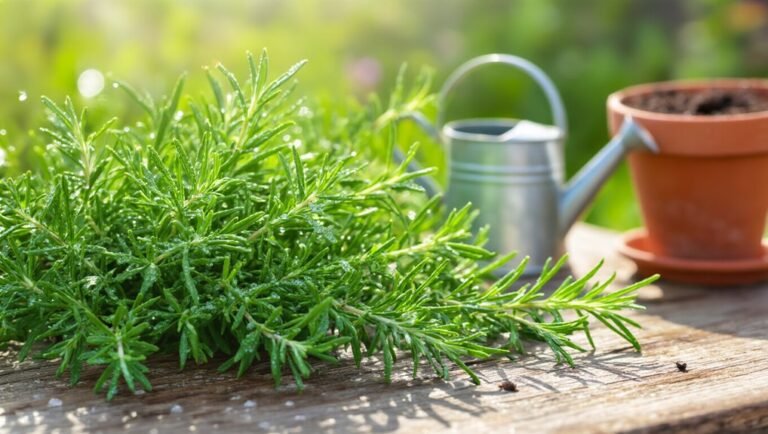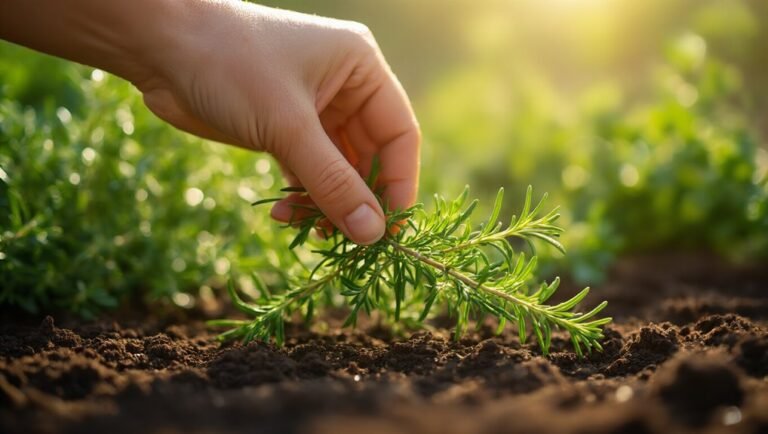To grow vibrant carnation flowers, pick a variety that suits your style, like the classic ‘Clove’ or colorful ‘Chabaud.’ Plant them in well-drained soil with a pH of 6.5 to 7.5 and ensure they get at least six hours of sunlight each day. Water deeply but infrequently, and use a balanced fertilizer every four to six weeks. Support your plants with stakes and carefully harvest blooms in the morning. Keep reading to discover more tips for thriving carnations!
Key Takeaways
- Choose the right carnation variety, selecting between hybrids for vibrant colors or traditional types for a classic look.
- Plant in a sunny location with well-drained soil, maintaining a temperature of 60°F to 70°F (15°C to 21°C).
- Water deeply but infrequently, aiming for about an inch of water per week, and fertilize every four to six weeks.
- Regularly inspect for pests and diseases, using insecticidal soap for pests and ensuring good air circulation to prevent fungal issues.
- Cut blooms in the morning when they begin to open, using sharp scissors and placing them in water immediately to keep fresh.
Choosing the Right Carnation Variety

When choosing the right carnation variety, consider that there are over 300 types available, each with unique characteristics.
You’ll want to think about the color, size, and fragrance that best suits your garden or arrangement. For example, if you prefer vibrant colors, look for the hybrid varieties like ‘Chabaud’ or ‘Green Trick’. If you’re after a classic look, try the traditional ‘Clove’ or ‘Picotee’ types.
Don’t forget to consider the growing conditions too, as some thrive in full sun while others prefer partial shade. For cut flowers, choose long-stemmed varieties for better arrangements. For healthy and vibrant carnations, make sure to plant them in high-quality garden soil that provides the right nutrients and drainage.
For more detailed advice on carnations and other blooms, you might find gardening books helpful as they offer in-depth tips and inspiration.
Ultimately, selecting the right variety will enhance your garden’s beauty and ensure you enjoy these stunning blooms to their fullest.
Happy gardening!
Preparing the Soil for Planting

After selecting the right carnation variety, the next step is to prepare the soil for planting. Start by choosing a well-draining location, as carnations thrive in soil that doesn’t retain excess moisture.
Test your soil’s pH; aim for a range of 6.5 to 7.5 for optimal growth. If your soil is too acidic, mix in lime to raise the pH. Using mulch in your garden can help regulate soil temperature and moisture, further supporting healthy carnation growth.
Then, enrich the soil with organic matter, like compost or well-rotted manure, to provide essential nutrients. Turn the top 12 inches of soil to ensure even distribution.
Finally, remove any weeds or debris that could compete with your carnations. Once the soil is ready, you’ll create a solid foundation for your beautiful blooms to thrive. For added benefits, consider using organic mulching materials such as straw to help retain moisture and suppress weed growth around your carnation plants.
Ideal Planting Conditions
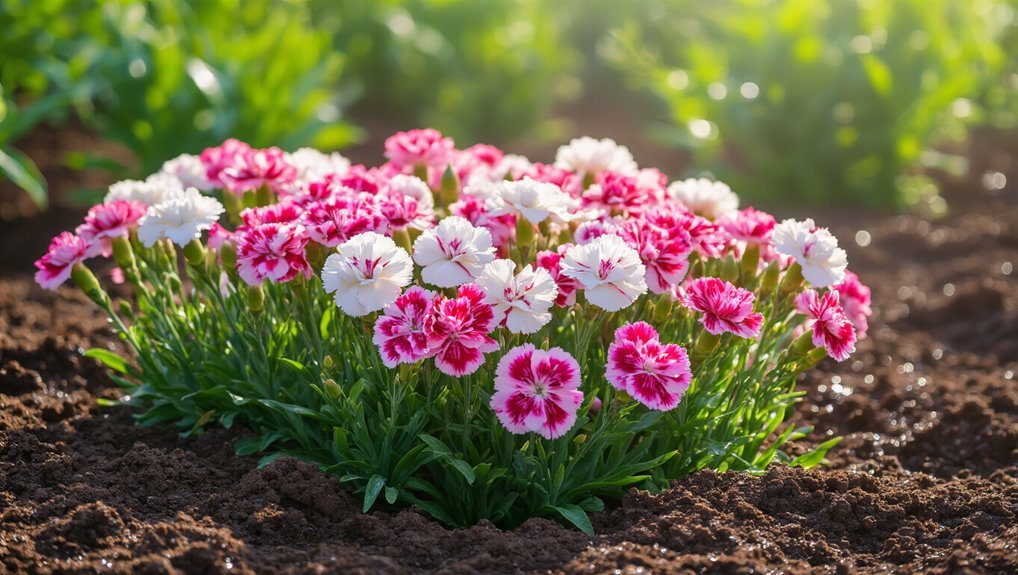
To ensure your carnations flourish, you’ll want to create ideal planting conditions. Start by selecting a sunny location; carnations thrive in full sun, so aim for at least six hours of direct sunlight daily. Using garden hoses can help you efficiently water larger beds or borders of carnations, ensuring even moisture distribution across your garden.
Next, focus on well-drained soil. Carnations dislike soggy roots, so mix in sand or perlite to improve drainage.
Lastly, maintain a temperature range between 60°F to 70°F (15°C to 21°C) during the growing season, as they prefer moderate climates.
For proper hydration, consider using essential watering cans to ensure your carnations receive a gentle and even watering without disturbing the soil.
Here’s a quick checklist for ideal planting conditions:
- Sunlight: At least 6 hours of direct sunlight daily.
- Soil: Well-drained, sandy or loamy soil.
- Temperature: 60°F to 70°F (15°C to 21°C).
With these conditions met, your carnations will thrive!
Watering and Fertilizing Your Carnations
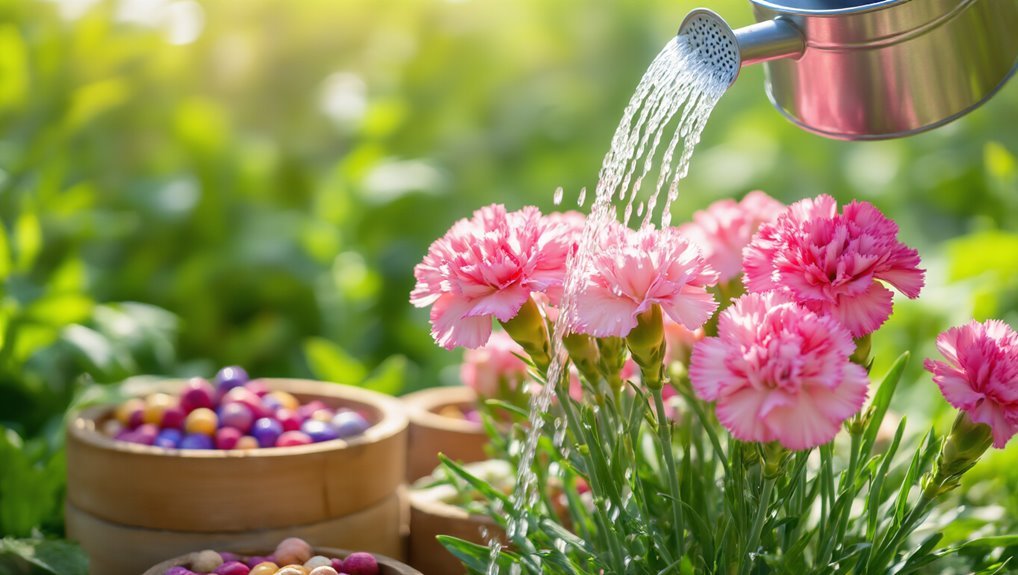
While providing the right amount of water and nutrients is crucial for healthy carnations, it’s important to strike a balance.
Water your carnations deeply but infrequently, allowing the soil to dry out slightly between waterings. This prevents root rot and encourages strong root development. Aim for about an inch of water per week, adjusting for weather conditions. For even better results, consider supplementing your watering routine with the best plant food options to ensure your carnations receive all the essential nutrients they need.
When it comes to fertilizing, use a balanced, water-soluble fertilizer every four to six weeks during the growing season. This gives your plants the nutrients they need to thrive.
Be cautious not to over-fertilize, as this can lead to lush foliage at the expense of blooms. For an easy and consistent way to feed your carnations, consider using Plant Fertilizer Tablets, which provide a steady supply of nutrients over time. Keep an eye on your plants, and you’ll soon enjoy vibrant, healthy carnations!
Pruning Techniques for Healthy Growth
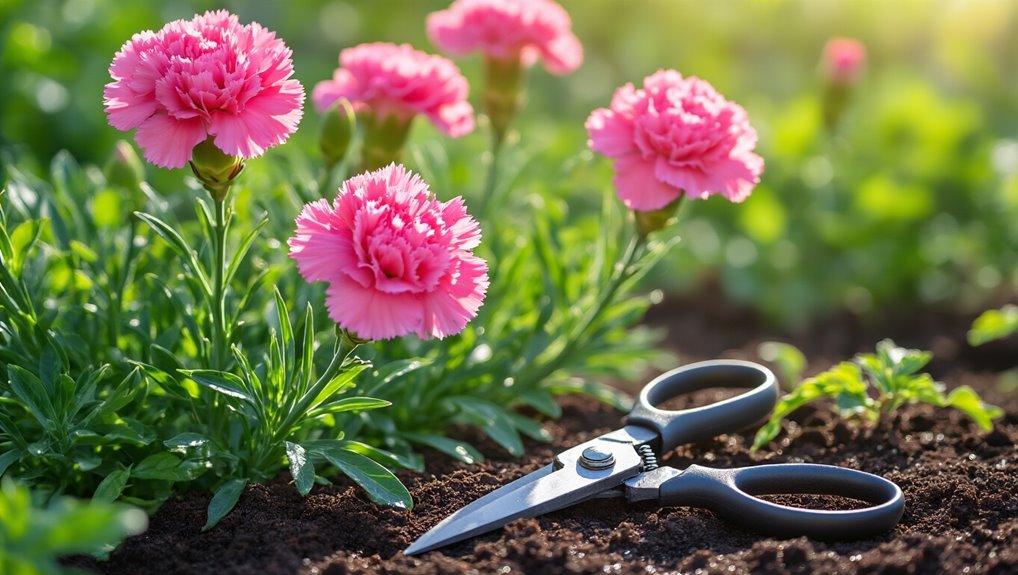
Pruning your carnations is essential for promoting healthy growth and maximizing blooms. By cutting back your plants at the right times and in the right ways, you can encourage more vibrant flowers. Many gardeners find that using weeding tools can make the process of clearing around your carnations before pruning much easier and more effective.
Here are three key pruning techniques to follow:
- Deadheading: Remove spent flowers regularly to stimulate new blooms and prevent the plant from wasting energy on seed production.
- Cutting Back: In early spring, trim back stems to about 4-6 inches above the ground to encourage bushier growth and stronger stems.
- Removing Diseased Foliage: Check for any yellowing or dead leaves and cut them away immediately to keep your plants healthy and thriving.
For best results, use pruning shears designed specifically for gardening to ensure clean cuts and minimize damage to your carnation plants.
Managing Pests and Diseases
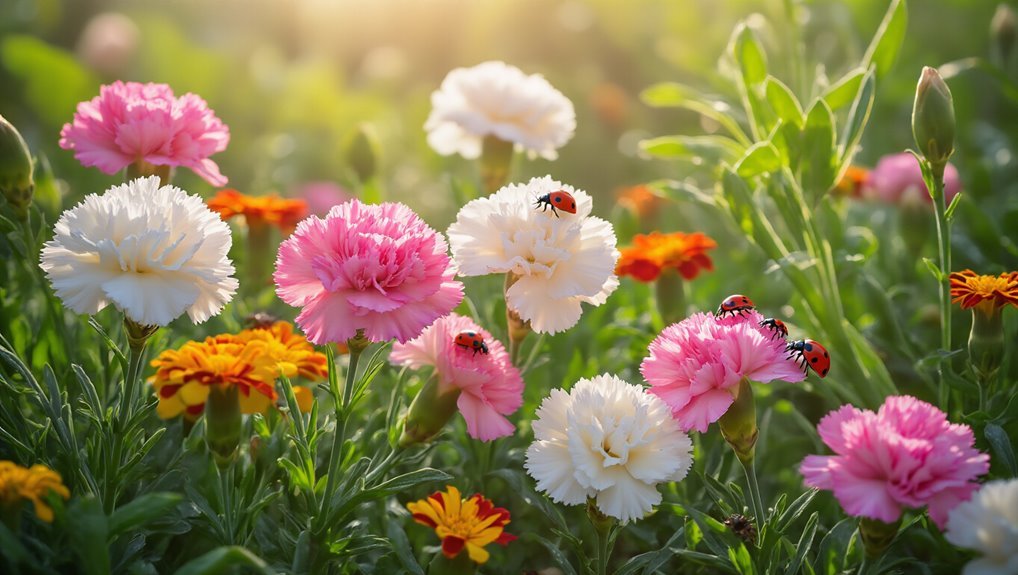
Managing pests and diseases is crucial for keeping your carnation flowers vibrant and healthy. Regularly inspect your plants for signs of trouble, such as yellowing leaves or unusual spots. Aphids and spider mites are common pests; you can often control them with insecticidal soap or neem oil. When choosing a treatment, consider using organic pest control solutions that are both effective and safe for your garden ecosystem. If you notice fungal diseases like powdery mildew, improve air circulation and avoid overhead watering.
Keeping your garden clean by removing debris helps prevent disease spread. Don’t forget to rotate your crops each season; this practice can minimize pest recurrence.
If problems persist, consult with a local extension service for targeted solutions. For more persistent infestations, consider using effective pest control products to safely manage pests without harming your carnations. By staying vigilant and proactive, you’ll ensure your carnations thrive throughout the growing season.
Supporting Your Carnation Plants
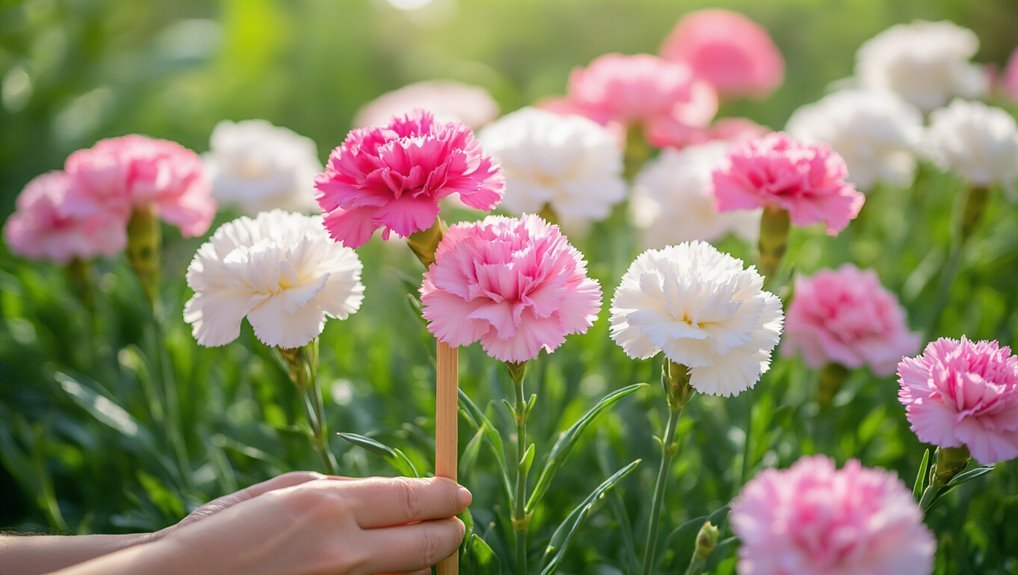
To ensure your carnation plants grow strong and upright, providing proper support is essential, especially as they begin to bloom.
Without support, your plants might flop over, which can hinder their growth and reduce blooms. Using quality trellis netting is a reliable way to help your carnations maintain their structure and maximize flower production.
Here are three effective ways to support your carnations:
- Stakes: Use bamboo or wooden stakes to gently tie your plants, ensuring they stay upright without damage.
- Cages: Consider using wire cages for larger varieties. They offer uniform support, helping to keep the blooms elevated.
- Trellis: For a more decorative option, install a trellis. This can enhance your garden’s aesthetics while providing sturdy support.
Adding a beautiful trellis not only supports your carnations but also enhances the overall appearance and charm of your garden.
Harvesting Fresh Blooms

When you’re ready to enjoy the vibrant beauty of your carnation flowers, knowing how and when to harvest them is crucial.
The best time to cut your blooms is in the morning after the dew has evaporated, ensuring they’re hydrated and fresh. Look for flowers that are just beginning to open, with tight buds and vibrant color. Using compost tumblers is an efficient way to turn plant trimmings from pruning your carnations into nutrient-rich compost for your garden.
Use sharp, clean scissors or pruning shears to make a clean cut, taking the stem at least 6 inches long. Avoid harvesting during extreme heat or rain, as this can affect their longevity.
Once cut, place your carnations in water immediately to keep them fresh. This way, you’ll maximize their vase life and enjoy their beauty to the fullest.
For gardeners interested in sustainable practices, using compost bins to recycle plant trimmings and organic waste can enrich your soil and support healthier carnation growth in the future.
Creating Stunning Arrangements
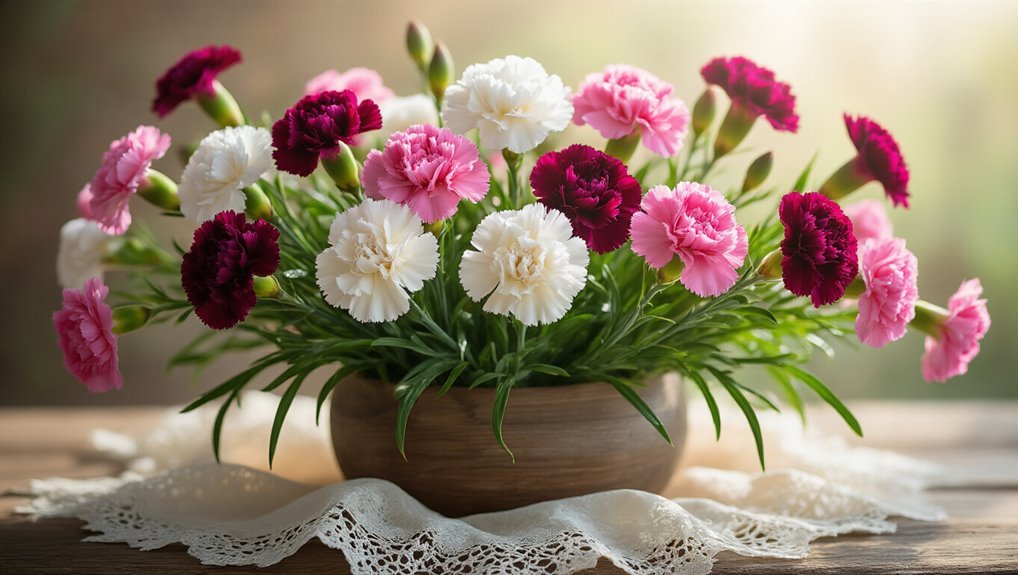
After harvesting those beautiful carnation blooms, it’s time to showcase their charm in stunning arrangements. Using stylish plant stands can help elevate the visual appeal of your floral displays and make your arrangements stand out.
Here’s how you can create eye-catching displays that highlight their vibrant colors and delightful fragrance.
- Choose a Focal Point: Start with a larger bloom or a unique vase to draw attention and set the tone for your arrangement.
- Mix Textures: Combine different types of greenery or other flowers, like eucalyptus or baby’s breath, to add depth and contrast to your arrangement.
- Vary Heights: Use blooms of differing heights to create visual interest. Place shorter flowers at the front and taller ones at the back to achieve balance.
For the best presentation, consider displaying your carnations in beautiful plant pots to further elevate your space and complement your arrangements.
With these tips, you’ll create arrangements that truly celebrate your gorgeous carnations!
Overwintering Carnations for Year-Round Growth
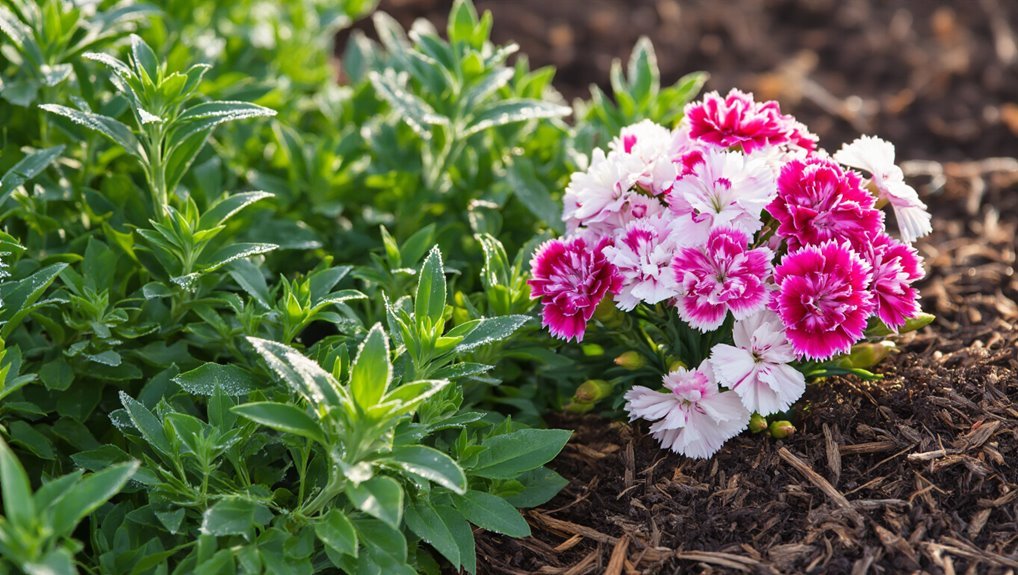
As temperatures drop and winter approaches, ensuring your carnations survive the colder months is crucial for their health and vibrant return in spring.
Begin by cutting back the plants to about six inches, removing any dead or damaged foliage. If you’re in a region with harsh winters, consider digging up the plants and potting them. Using Garden Tool Organizers can help keep your tools tidy and accessible as you prepare your carnations for winter.
Place them in a cool, dark area, like a garage or basement, where temperatures stay above freezing. Water sparingly, just enough to keep the soil slightly moist.
If your carnations are in the ground, apply a thick layer of mulch to insulate the roots.
As spring arrives, gradually reintroduce them to sunlight and resume regular watering to promote healthy growth.
To make the process easier on your knees and back, consider using garden kneelers while tending to your carnations during winter preparations.
Frequently Asked Questions
Can Carnations Be Grown Indoors Successfully?
Yes, you can grow carnations indoors successfully. Just make sure they get plenty of sunlight, maintain good air circulation, and use well-draining soil. With proper care, you’ll enjoy beautiful blooms right in your home.
What Colors Do Carnation Flowers Come In?
Imagine a garden bursting with color! Carnation flowers come in a stunning array of shades, including pink, red, white, yellow, and purple. You’ll find some with unique patterns, making them perfect for any bouquet.
How Long Do Carnation Blooms Last After Cutting?
Carnation blooms typically last about 7 to 14 days after cutting, depending on care. To extend their life, keep them in fresh water, avoid direct sunlight, and trim the stems regularly. Enjoy their beauty longer!
Are Carnation Flowers Toxic to Pets?
Carnation flowers aren’t toxic to pets, so you don’t have to worry if your furry friend sniffs or nibbles on them. However, it’s always best to monitor their behavior around any plants.
Can I Propagate Carnations From Cuttings?
Yes, you can propagate carnations from cuttings. Take healthy stems, remove lower leaves, and place them in moist soil. Keep them warm and watered, and you’ll soon see new growth and thriving plants.
Conclusion
By following these steps, you’ll be well on your way to cultivating beautiful carnation flowers that brighten up any garden. Remember, patience is key; good things come to those who wait. With proper care, your plants will thrive and reward you with stunning blooms. Keep your gardening tools handy, and don’t hesitate to experiment. Soon enough, you’ll be creating gorgeous arrangements that showcase your hard work and passion for gardening. Happy planting!
